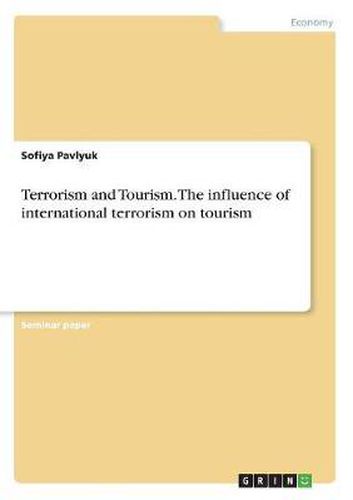Readings Newsletter
Become a Readings Member to make your shopping experience even easier.
Sign in or sign up for free!
You’re not far away from qualifying for FREE standard shipping within Australia
You’ve qualified for FREE standard shipping within Australia
The cart is loading…






Seminar paper from the year 2017 in the subject Economics - Macro-economics, general, grade: 2, Christian-Albrechts-University of Kiel, language: English, abstract: Introdu tion Tourism is among the world’s biggest industry (Eilat & Einav, 2004). It has a very big impa t on the e onomy and bring a lot of money for it. The tourism industry is sus eptible to sho ks, su h as terror atta ks or the in iden e of infe tious disease (Edmonds & Mak, 2006). In the 21st entury, tourism emerges as a signifi ant in ome generating se tor as well as weapon for growth and survival for various ountries. I sele t Enders and Sandler’s (2002) view of terrorism as the premeditated use or threat of use of extra-normal violen e or brutality by sub-national groups to obtain a politi al, religious, or ideologi al obje tive through intimidation of a huge audien e, usually not dire tly involved with the poli ymaking that the terrorists seek to influen e. Although the motives of terrorists may be very different, their a tions follow a standard pattern with terrorist in idents assuming a variety of forms: airplane hija kings, kidnappings, assassinations, threats, bombings, and sui ide atta ks. Terrorist atta ks are intended to apply suffi ient pressures to a government. Sin e 80s, s holars from diverse dis iplines are trying to examine the relationship between terrorism and tourism (Ri hter 1989; Ri hter and Waugh 1986), the e onomi impa ts of terrorism (Enders and Sandler 1991; Enders, Sandler and Parise 1992), impli ations for tourism marketing (Brady and Widdows 1988; D'Amore and Anuza 1986; Hollier 1991; Sonmez 1994). The number of e onomi s of terrorism studies has in reased dramati ally sin e 11 September 2001, where some 3,000 people died (Enders and Sandler, 2006), opening up a new dimension in terrorism, as well as a series of other terror atta ks between 2001 and 2003. In the last de ade a lot of ountries had terror atta ks, su h as Fran e (2012, 2015), US, Spain, the N
$9.00 standard shipping within Australia
FREE standard shipping within Australia for orders over $100.00
Express & International shipping calculated at checkout
Seminar paper from the year 2017 in the subject Economics - Macro-economics, general, grade: 2, Christian-Albrechts-University of Kiel, language: English, abstract: Introdu tion Tourism is among the world’s biggest industry (Eilat & Einav, 2004). It has a very big impa t on the e onomy and bring a lot of money for it. The tourism industry is sus eptible to sho ks, su h as terror atta ks or the in iden e of infe tious disease (Edmonds & Mak, 2006). In the 21st entury, tourism emerges as a signifi ant in ome generating se tor as well as weapon for growth and survival for various ountries. I sele t Enders and Sandler’s (2002) view of terrorism as the premeditated use or threat of use of extra-normal violen e or brutality by sub-national groups to obtain a politi al, religious, or ideologi al obje tive through intimidation of a huge audien e, usually not dire tly involved with the poli ymaking that the terrorists seek to influen e. Although the motives of terrorists may be very different, their a tions follow a standard pattern with terrorist in idents assuming a variety of forms: airplane hija kings, kidnappings, assassinations, threats, bombings, and sui ide atta ks. Terrorist atta ks are intended to apply suffi ient pressures to a government. Sin e 80s, s holars from diverse dis iplines are trying to examine the relationship between terrorism and tourism (Ri hter 1989; Ri hter and Waugh 1986), the e onomi impa ts of terrorism (Enders and Sandler 1991; Enders, Sandler and Parise 1992), impli ations for tourism marketing (Brady and Widdows 1988; D'Amore and Anuza 1986; Hollier 1991; Sonmez 1994). The number of e onomi s of terrorism studies has in reased dramati ally sin e 11 September 2001, where some 3,000 people died (Enders and Sandler, 2006), opening up a new dimension in terrorism, as well as a series of other terror atta ks between 2001 and 2003. In the last de ade a lot of ountries had terror atta ks, su h as Fran e (2012, 2015), US, Spain, the N